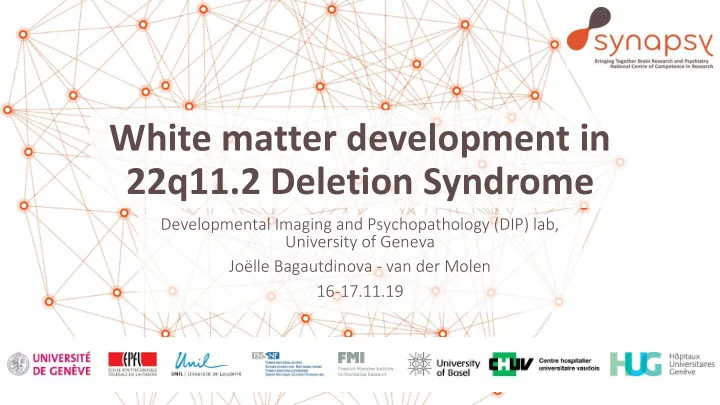

White matter development in 22q11.2 Deletion Syndrome Developmental Imaging and Psychopathology (DIP) lab, University of Geneva Joëlle Bagautdinova - van der Molen 16-17.11.19
Introduction 3
Introduction • The brain continues to mature after birth and until adulthood More grey matter Less grey matter Birth Adulthood • Brain development is determined by a combination of genetic and environmental factors 4
Introduction • What is the brain made of? Neurone Grey matter Includes neuronal bodies White matter Mainly myelinated axons The « cables » of the brain 5
Introduction • What is the brain made of? Neurone Grey matter Includes neuronal bodies White matter Mainly myelinated axons The « cables » of the brain 6
Introduction White matter development in healthy individuals • White matter development continues until adulthood • White matter development is mainly non-linear • Maturation peaks ranging from 20 to 40+ years depending on the brain region Age White matter Age Age Age From Lebel and Beaulieu, 2011; Lebel et al., 2012 7
Introduction White matter in individuals with 22q11.2DS • Widespread alterations of white matter volume and microstructure in 22q11.2DS • Lack of age-related changes in most white matter tracts Canu et al., 2015; Carletti et al., 2012; Davis et al., 2003; Scariati et al., 2016 Limitations • Limited sample sizes • Findings are based on cross-sectional studies • Discordant results (for a review, see Scariati et al., 2016) 8
Introduction White matter in individuals with 22q11.2DS • Widespread alterations of white matter volume and microstructure in 22q11.2DS • Lack of age-related changes in most white matter tracts Canu et al., 2015; Carletti et al., 2012; Davis et al., 2003; Scariati et al., 2016 White matter development in 22q11.2DS is largely unknown White matter ? 9
White matter development in 22q11.2DS 10
White matter development in 22q11.2DS Objective Characterize the developmental trajectories of white matter microstructure in 22q11.2DS ‣ Clarify the maturational profile of white matter microstructure related to a high genetic risk for psychosis ‣ Method : longitudinal (repeated measures) approach; mixed models regression 11
White matter development in 22q11.2DS Main white matter tracts of the brain Left lateral view Right lateral view 12
White matter development in 22q11.2DS Sample description • From 5 to 35 years old • 1 - 3 time points (TPs) • ~ 3 years interval between TPs • n = 201 Participants • 302 scans Female Male Total Controls 52 48 100 22q11.2DS 50 51 101 Total 102 99 201 Age at scan 13
White matter development in 22q11.2DS • White matter development is affected in 22q11.2DS Radial Diffusivity Mean Diffusivity Right cingulum (CCG) Left cingulum (CCG) p < 0.001 p < 0.001 MD RD Tracts with altered microstructure Age (years) Age (years) Axial Diffusivity Fractional Anisotropy Left superior longitudinal fasciculus (SLFT) Right cingulum (CCG) p < 0.001 p < 0.001 FA AD Age (years) Age (years) 14
White matter development in 22q11.2DS • Multivariate approach to assess the impact or clinical risk factors on white matter maturation in 22q11.2DS 15
White matter development in 22q11.2DS • Clinical risk factors have a significant impact on white matter development in 22q11.2DS p = 0.03 16
Take home message 17
Take home message • 22q11DS is associated with widespread alterations of white matter microstructure • Alterations point to a combination of neuropathological mechanisms in 22q11.2DS: ‣ RD reductions suggest excessive myelination ‣ AD reductions suggest axonal disruptions, reduced tracts organisation or reduced axon diameter Healthy neuron Fiber bundle AD reduction AD reduction RD reduction AD reduction Reduced Reduced Hypermyelination Axonal damage axonal diameter tract organisation 18
Take home message • 22q11DS is associated with widespread alterations of white matter microstructure • Alterations point to a combination of neuropathological mechanisms in 22q11.2DS: ‣ RD reductions suggest excessive myelination ‣ AD reductions suggest axonal disruptions, reduced tracts organisation or reduced axon diameter • Alterations are already visible early during development, pointing to pre-, perinatal or early childhood altered maturation of white matter microstructure • Evidence for typical developmental rates (similar changes occurring 22q112DS and typically developing controls) • Clinical risk factors for psyc sychosi sis have an impact on white matter microstructure 19
Thank you for your attention! Thank you!
Recommend
More recommend